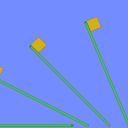Plan incliné
From Algodoo
Galileo´s inclined planes
| Language: | English |
|---|---|
| Description: | Galileo used rolling balls on inclined planes to develop his nderstanding of acceleration. He did not have proper timing devices to measure the high speeds of free fall and used different angles of inclined planes to model different accelerations. The greater the slope of the incline, the greater the acceleration of the ball. Galileo found a ball rolling down a certain incline picked up same amount of speed for each second. That gain is acceleration. |
| Target: | Key Stage 3 |
| Category: | Demonstration, Exercise |
| Discipline: | Gravity, Motion |
| Learning objectives: |
|
| In class: | Discuss how something on a plane can be set into motion.
Discuss the experiment that Galileo performed in order to understand the motion of free fall. Why did he do this experiment? Discuss how this can be visualized and explored in Algodoo. Let the students create scenes in Algodoo using the suggestions you came up with together or let them use their own ideas. Help the students make decisions and ask guiding questions. Encourage the students to follow the procedure Create – Predict – Interact – Evaluate. Allow the students to follow-up and share their experiences in class after the simulation. |
Steps in Algodoo
Create a scene
Create five rectangular boxes as planes and rotate them to the different angles between 0° and 90°. Make the planes frictionless. Use identical boxes to slide down the planes. A rectangular box, fixed to the background, can be used as a starting device. Remove the shelf at the start to make the boxes start simultaneously.
Make a prediction
Which box reaches the end of its plane first?
Run/Interact
Start the simulation and watch the boxes slide down the planes.
Evaluate
Which plane is faster? Which ball is picking up the most speed for each second? Is it possible to check how much speed the balls are picking up? Run the simulation again and check for velocities. Observe which forces that are involved in the motion. What is the acceleration of the vertical plane? Is there a pattern in how speed is picked up for each plane?
Run/Interact
Run the simulation as an experiment. Make sure that velocity representation and values are turned on. Use a timer and pause the simulation every second. Write down the velocity for each box in a table. Plot velocity as a function of time and study the graphs.
Evaluate
What does the slope of the graph mean?





